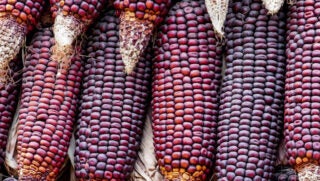Have you had a Beyond Burger yet? How about an Impossible Burger? Both are getting a lot of press these days, and a lot of interest where they are available. I had a Beyond Burger a few weeks ago. For a veggie burger, it tasted quite meaty. But at three times the price of a Burger King Whopper, I won’t be having another any time soon. Price hasn’t affected demand yet — the makers of both fake burgers are having trouble keeping up. Beyond Meat had a very successful public offering in May, and projects $210 million in sales this year.
And soon there will be plenty of competition. Meat giant Tyson Foods ($40 billion in 2018 sales) is launching its “Raised & Rooted” brand of plant-based and blended meat items. Chicken nuggets made with pea protein, burgers made with plant protein blended with meat, and sausage made with chicken, chickpeas, and black beans are some of their entries.
Perdue Foods, another food giant, has introduced plant-based chicken nuggets. Nestle, the world’s largest food company, is launching the Awesome Burger, made with yellow peas and wheat as the key ingredients. Nestle says they chose peas as a protein source instead of soybeans because peas promote sustainability and improve soil health. Wait, what? When did soybeans not promote sustainability and improve soil health? Apparently the canard promoted by agriculturally uneducated pundits that a corn-soybean rotation is a “monoculture” that destroys soils and is unsustainable has soaked into the brains of Nestle management. Soybeans are more robust nitrogen producers for the following crop than peas because of their long, wet, and warm growing season. When grown no-till in rotation with no-till corn, and a cover crop grown in the winter, the rotation is not only sustainable, it is regenerative.
Peas are grown rotated with small grains where seasons are too short or too dry to grow soybeans. Peas would not be a good rotation substitute for soybeans where summers are long, hot, and wet (e.g., the Corn Belt). But it is good that food companies have discovered the protein potential of peas. It gives pea growers another needed market.
Beyond Meat uses peas as its protein source and beet juice as its “blood” source in the Beyond Burger. Impossible Foods’ burger uses protein from soybeans and potatoes. Their controversial “blood” source is soy leghemoglobin, the red-colored protein found in the nodules attached to the roots of soybeans and other leguminous plants. Here Rhizobium bacteria take nitrogen from the air and supply it to the plant in exchange for some carbohydrate from the plant — a symbiotic arrangement.
Leghemoglobin is very similar to blood hemoglobin. Blood hemoglobin absorbs oxygen in the lungs and ferries it to tissues where it exchanges it for carbon dioxide, a feat made possible by differences in pH in the lungs versus tissues. Leghemoglobin is 10 times more efficient than hemoglobin at binding oxygen. Its function in the nodule is to absorb excess oxygen that would poison the nitrogen-fixing process carried out by the Rhizobium.
Leghemoglobin in a burger is contentious for a couple of reasons. Leghemoglobin has never been consumed by humans before, and Impossible Foods did very little safety testing before including it in their burger. The FDA advised Impossible Foods that they have not proven the safety of leghemoglobin, but the FDA has not prohibited the company from marketing their burger. Impossible Foods insist leghemoglobin is identical to the “heme” humans have consumed for millennia, but it is not. The heme portion of the molecule is an iron atom attached to four nitrogen atoms, each of which is attached to four carbon atoms, forming what is called a porphyrin ring. This iron-binding porphyrin is the foundation of a plethora of compounds called hemoproteins. The side chains attached to the heme structure determine the protein function, and blood hemoglobin is not the same protein as leghemoglobin. (An interesting side note: If the iron is replaced with a magnesium atom, one result is chlorophyll.)
The other reason it is controversial is that the Impossible Foods’ leghemoglobin is not produced by soybeans. It is produced in fermenters by yeast that have been genetically modified. Soybean genes were inserted into the yeast that allow the yeast to produce leghemoglobin, which is then extracted, concentrated, and included in the burger recipe. They justify it to their predominantly anti-GMO customer base by saying that, compared to a beef burger, the Impossible Burger uses 96 percent less land, 87 percent less water, and produces 89 percent less greenhouse gas emissions, and 92 percent less aquatic pollutants. Believe that? I don’t. But they are making a case, intentionally or unintentionally, for the safe use of GMOs in our food supply.
Several companies are working on lab-grown meats, fish, and milk proteins. Will cell-based and plant-based substitutes for real meat and milk significantly impact the animal meat industry? Milk is already suffering from competition with plant-based milks. Barclay’s Bank predicts such substitutes will capture 10 percent of the meat market in a decade, and be worth $140 billion. On the other hand, the market for animal protein will expand as incomes rise in underdeveloped countries, especially in Africa and South Asia. In 2011 the FAO (United Nations Food and Agriculture Organization) predicted the world would need 73 percent more meat and 58 percent more dairy by 2050. So don’t retire your herd just yet.
Jack DeWitt is a farmer-agronomist with farming experience that spans the decades since the end of horse farming to the age of GPS and precision farming. He recounts all and predicts how we can have a future world with abundant food in his book “World Food Unlimited.” This article was republished from Agri-Times Northwest with permission.



